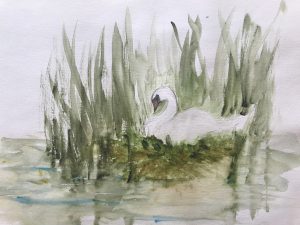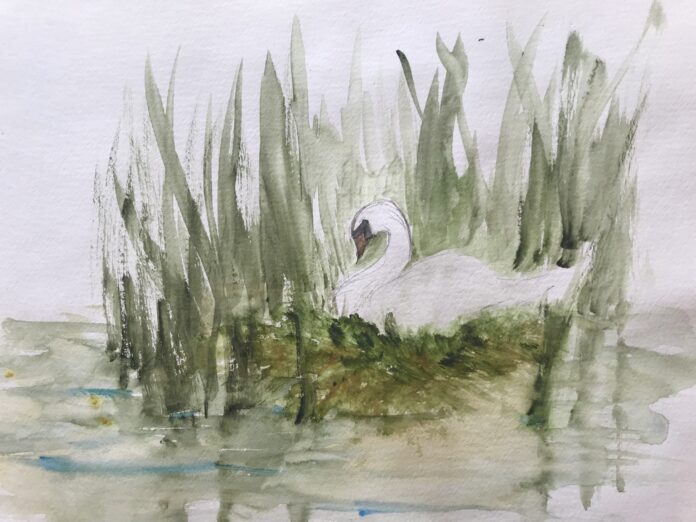BY LESLIE REGO

I am very familiar with the swans at the Sun Valley Lodge, but I have never seen a mute swan in the wild. Mute swans, native to Eurasia, are an introduced species in North America. They were imported in the late 19th century as decorative birds for parks and manor houses. Today, the bird is considered an invasive species.
A group of swans is called a “bevy,” or a “wedge” in flight. The male swan is called a “cob,” from Middle English cobbe, alluding to a leader of a group. The female is referred to as a “pen,” from the usage of her feathers as quills for writing. The babies are called “cygnets,” from the Latin word for swan, cygnus.
The name “mute” describes the bird’s less vocal nature compared to other swan species. The loudest noise made by the mute swan is the throbbing of its wings as it takes off to fly. But these swans also make snorting and grunting noises and they will definitely hiss at intruders, especially if they feel threatened. I once had one of the Sun Valley swans attack me during a ceremony I attended on the lodge grounds! The swan must have felt endangered by the gathered group. Ever since, I have had a healthy wariness of the large and powerful bird.
The necks of the mute swans are long and gracefully curved. Generally, we think of the swan as being all white, but often the head and neck are stained tan from the muddy waters they dive into as they forage for food.
Walking along the Sile river in Italy, I came across a mute swan’s nest. This was the first time I have seen a swan’s nest in the wild. The nest was at least 4 feet wide. The intricate web of interlacing reeds and branches wove around and around, raising the nest high above the water. In the very center sat a beautiful swan, patiently holding vigil over her clutch of eggs.
Every so often the swan stood and stretched, fluffing her wings (although the male is also known to sit on the nest) and rearranging her body to find a better position. The bird moved her long neck from side to side, repositioning the reeds to make a more comfortable environment. When the swan stood, I could see four or five tan-colored eggs about 3 inches in diameter.
My first experiences with swans were with the swans that reside in the ponds of the Sun Valley Lodge. Seeing the wild swans along the Sile river brought me full circle from the introduced mute swans of North America to the native habitat of the swan within Europe.
Leslie Rego is an Idaho Press Club award-winning columnist, artist and Blaine County resident. To view more of Rego’s art, visit leslierego.com.



